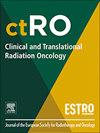A first evaluation of the efficacy of minibeam radiation therapy combined with an immune check point inhibitor in a model of glioma-bearing rats
IF 2.7
3区 医学
Q3 ONCOLOGY
引用次数: 0
Abstract
Glioblastoma multiforme (GBM) continues to be a hopeless case today. Its treatment involves the use of multiple modalities. One of them is radiation therapy (RT), that is limited by normal tissue tolerances in GBM patients. GBM is widely recognized to induce local and systemic immunosuppression, which is a hindrance to the use of immune-modulating therapies. One possible strategy is to ally immunotherapy (IT) with novel RT approaches able to revert the immunosuppressive nature of GBM. One example is minibeam radiation therapy (MBRT). Preclinical experiments have shown that MBRT leads to a remarkable widening of the therapeutic window for GBM and elicits an effective immune priming. The main hypothesis of this study is that the activation of the immune system by MBRT would synergize with IT enhancing tumour control and minimizing toxicities. To validate it, in vivo experiments in a glioma rat model were performed. The goal was to assess the gain in survival of animals treated with MBRT, MBRT plus an immune check point inhibitor (ICI) versus conventional RT (CRT) or ICI alone. All treatments (ICI alone, CRT, CRT + ICI, MBRT and MBRT + ICI) increased survival with respect to the non-irradiated controls. However, the high radiation dose (30 Gy) delivered in one fraction in CRT is highly detrimental for normal tissues contrary to MBRT. The combination of CRT plus ICI appeared to be toxic. MBRT + ICI surpassed the survival rate with respect to ICI alone. When ICI was used with high-dose conventional irradiation, tumor eradication was observed in 6 out 8 animals. However, the survival was statistically equivalent to MBRT plus ICI, with a tendency to reduce survival in comparison with CRT alone, suggesting acute toxicity associated with this multimodal treatment.
In conclusion, our results suggest some advantages for MBRT in combination with ICI. We need to conduct further work to determine the optimal RT-IT combination and schedule for ICI injection and MBRT irradiation.
微束放射治疗联合免疫检查点抑制剂在胶质瘤大鼠模型中的疗效的首次评估。
多形性胶质母细胞瘤(GBM)今天仍然是一个没有希望的病例。其治疗涉及使用多种方式。其中之一是放射治疗(RT),它受到GBM患者正常组织耐受性的限制。人们普遍认为GBM可诱导局部和全身免疫抑制,这阻碍了免疫调节疗法的使用。一种可能的策略是将免疫治疗(IT)与能够恢复GBM免疫抑制特性的新型RT方法联合起来。其中一个例子是微束放射治疗(MBRT)。临床前实验表明,MBRT可显著扩大GBM的治疗窗口,并引发有效的免疫启动。本研究的主要假设是MBRT激活免疫系统将与IT协同作用,增强肿瘤控制并减少毒性。为了验证这一点,在神经胶质瘤大鼠模型中进行了体内实验。目的是评估MBRT、MBRT加免疫检查点抑制剂(ICI)治疗与常规RT (CRT)或ICI单独治疗相比,动物生存率的提高。所有治疗(ICI单独、CRT、CRT + ICI、MBRT和MBRT + ICI)均比未放疗的对照组增加了生存率。然而,与MBRT相反,CRT中一个部分的高辐射剂量(30 Gy)对正常组织非常有害。CRT加ICI的组合似乎是有毒的。MBRT + ICI的生存率高于单独ICI的生存率。当ICI与高剂量常规照射联合使用时,8只动物中有6只肿瘤根除。然而,生存率在统计学上与MBRT + ICI相当,与单独CRT相比,有降低生存率的趋势,表明这种多模式治疗与急性毒性有关。总之,我们的结果表明MBRT联合ICI有一些优势。我们需要进一步的工作来确定ICI注射和MBRT照射的最佳RT-IT组合和时间表。
本文章由计算机程序翻译,如有差异,请以英文原文为准。
求助全文
约1分钟内获得全文
求助全文
来源期刊

Clinical and Translational Radiation Oncology
Medicine-Radiology, Nuclear Medicine and Imaging
CiteScore
5.30
自引率
3.20%
发文量
114
审稿时长
40 days
 求助内容:
求助内容: 应助结果提醒方式:
应助结果提醒方式:


